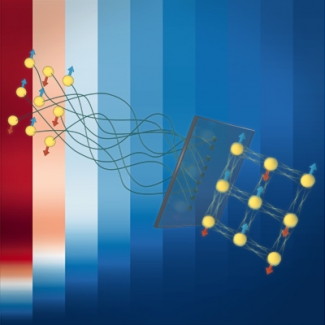When the Rey theory group first modeled a quantum system at JILA, it investigated the interactions of strontium atoms in the Ye group’s strontium-lattice clock. The quantum behavior of these collective interactions was relatively simple to model. However, the group has now successfully tackled some more complicated systems, including the ultracold polar KRb molecule experiment run by the Jin and Ye groups. In the process, the group has developed a new theory that will open the door to probing quantum spin behavior in real materials; atomic, molecular and optical gases; and other complex systems. The new theory promises important insights in different areas of physics, quantum information science, and biology.
The new theory comes compliments of research associates Johannes Schachenmayer and Alexander Pikovski as well as Fellow Ana Maria Rey. It uses some clever classical techniques to model quantum spin dynamics. This capability is important because there is no computer powerful enough to handle a purely quantum description of the spins of particles in complicated systems that are not in equilibrium. Remarkably, the theory is also able to capture the long-range interactions where particles communicate information about the quantum state of their spins even to particles farther away than their nearest neighbors.
The new approach starts with a mixture of many particles in classical spin-up or spin-down states. This statistical mixture aims to represent intrinsic correlations induced by the long-range interactions in a quantum state consisting of superpositions of particles in both possible spin states. Superpositions involving many particles are part of what is too complicated about quantum spin dynamics to analyze with today’s supercomputers.
The researchers used a semi-classical probability-based “Monte Carlo” method to create a mixture of spin-up and spin-down particles. Over time, they monitored the spin behaviors of the system as they evolved and observed the development of correlations between pairs of spins. Eventually the spins became entangled, just as one would expect if the system had been modeled quantum mechanically rather than classically. Entanglement means that the particles became informed of the state of their partners and, if something happens to one of them, all the particles respond.
Thus, even though the researchers started out with a semi-classical description of spins, the end result was entanglement, as expected in a quantum mechanical system.
What’s more, the new theory accurately predicts many aspects of spin dynamics predicted by previous analyses and calculations. This new method is expected to help theorists model the quantum spin behaviors observed in the JILA cold polar molecule experiment and other complex, out-of-equilibrium systems.—Julie Phillips




